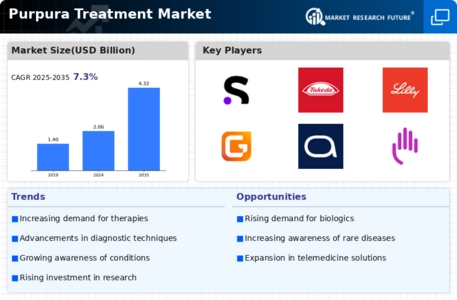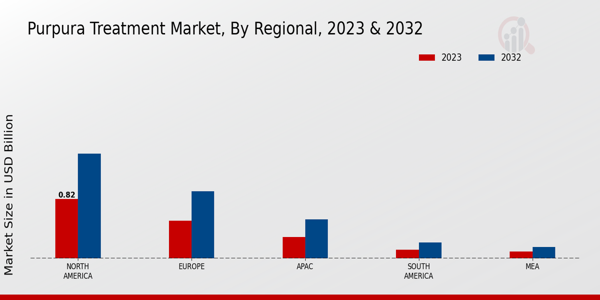Rising Incidence of Purpura
The Global Purpura Treatment Market Industry is witnessing an increase in the incidence of purpura, which is driving demand for effective treatment options. Factors such as genetic predispositions and environmental triggers contribute to the rising cases. For instance, the prevalence of immune thrombocytopenic purpura (ITP) is particularly notable, with estimates suggesting that it affects approximately 4.5 per 100,000 people annually. This growing patient population necessitates advancements in treatment modalities, thereby propelling market growth. As the market is projected to reach 2.06 USD Billion in 2024, addressing the needs of this demographic becomes increasingly critical.
Growing Geriatric Population
The aging population is a significant driver of the Global Purpura Treatment Market Industry. Older adults are more susceptible to various health conditions, including purpura, due to age-related changes in the immune system and blood vessel integrity. As the global geriatric population continues to rise, the demand for effective purpura treatments is expected to increase correspondingly. By 2035, the number of individuals aged 65 and older is projected to reach 1.1 billion globally, creating a substantial market for purpura therapies. This demographic shift underscores the need for tailored treatment approaches to address the unique challenges faced by older patients.
Market Trends and Projections
Regulatory Support and Funding
Regulatory support and funding initiatives are playing a crucial role in the Global Purpura Treatment Market Industry. Governments and health organizations are increasingly recognizing the need for research and development in rare diseases, including purpura. Funding programs and grants aimed at supporting clinical trials and innovative treatment development are becoming more prevalent. This support not only accelerates the introduction of new therapies but also enhances patient access to existing treatments. As a result, the market is poised for growth, with stakeholders actively collaborating to improve treatment options and outcomes for purpura patients.
Increased Awareness and Diagnosis
The Global Purpura Treatment Market Industry is benefiting from heightened awareness and improved diagnostic capabilities. As healthcare providers and patients become more informed about purpura, earlier diagnosis and treatment initiation are occurring. Enhanced diagnostic tools, such as advanced imaging techniques and laboratory tests, facilitate accurate identification of purpura types, leading to timely interventions. This trend is particularly relevant as the market is expected to grow at a CAGR of 6.98% from 2025 to 2035. Consequently, the increased focus on awareness campaigns and educational initiatives is likely to drive market expansion.
Advancements in Treatment Modalities
Innovations in treatment modalities are significantly influencing the Global Purpura Treatment Market Industry. The development of novel therapies, including biologics and targeted treatments, offers new hope for patients suffering from various forms of purpura. For example, the introduction of thrombopoietin receptor agonists has shown promising results in increasing platelet counts in patients with ITP. These advancements not only improve patient outcomes but also expand the therapeutic landscape, attracting investments and research initiatives. With a projected market value of 4.32 USD Billion by 2035, the emphasis on innovative treatments is likely to shape the future of purpura management.
























